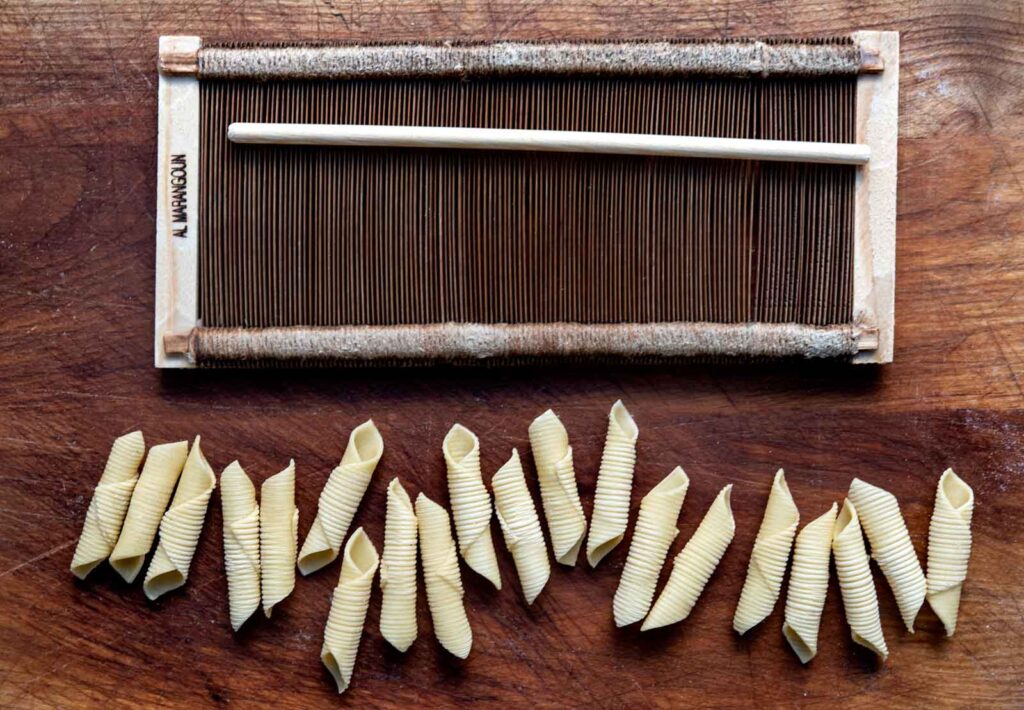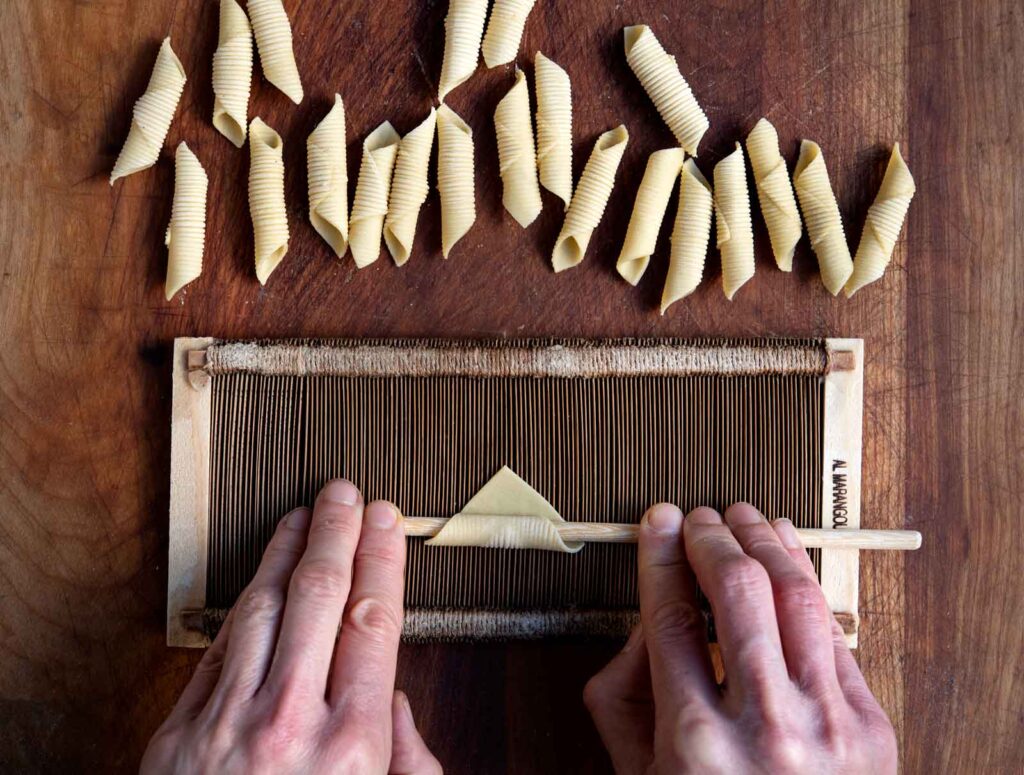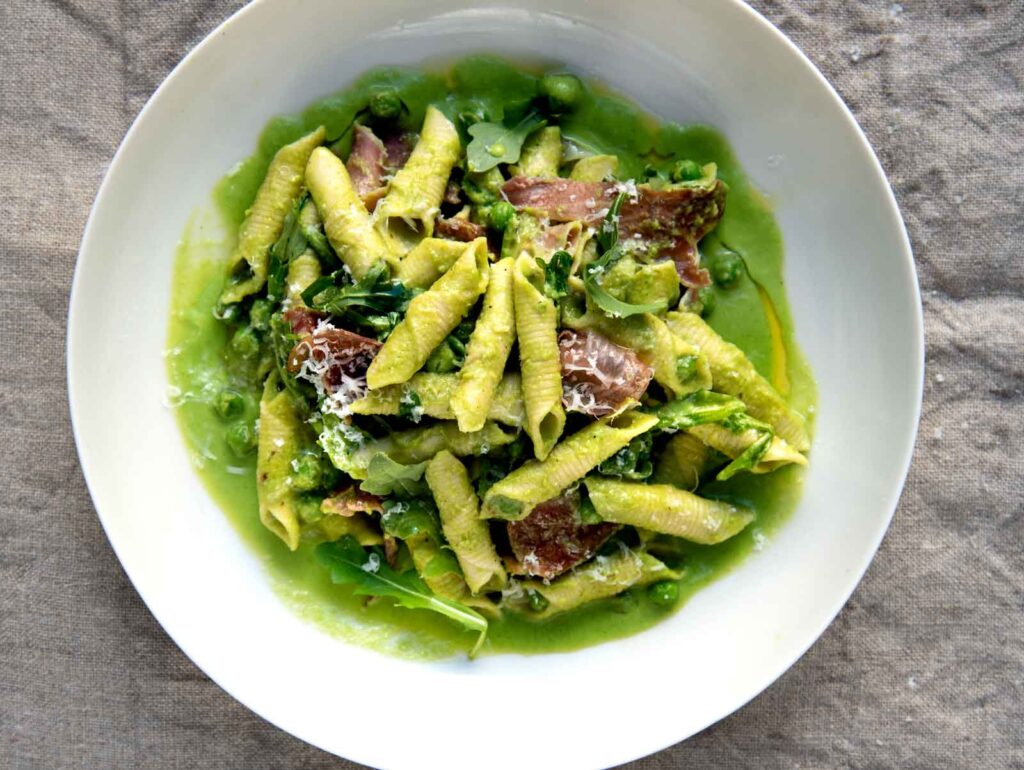I’m working my way through the Encyclopedia of Pasta by Oretta Zanini de Vita. Only 350+ pasta shapes to go (lol).
Today is all about garganelli; a tubular pasta from Emilia-Romagna. Its name derives from the dialect word garganel, meaning ‘chicken’s gullet,’ which the ridged garganelli apparently resemble.
It’s a fairly easy shape to make. Mix the dough (00 flour and eggs; I added a little Parmesan cheese and dash of nutmeg, which I read is sometimes used). Then, roll out the dough, cut into squares (mine are 1 1/2-inch squares), then roll over a ridged surface known as a pettine. Alternatively, you can use a more commonly found gnocchi board to form the ridges. Its ridges are not as close together as a pettine, but will still do the job. The ridges, as you can see above, help to hold the sauce.
As for the sauce, you’ll find garganelli traditionally served with a hearty meat ragú. But, as I’m eager for spring to arrive, I decided to pair my garganelli with a lighter, spring-ier sauce — an herby (tarragon and sage) pea puree — along with speck and some baby arugula.
Hmm, what shape to make next?



Garganelli with Pea Puree
Ingredients
- 2 tbsp butter
- 1/2 cup white onion, diced
- 1 garlic clove, sliced
- 1 cup shelled fresh or frozen peas
- leaves of a sprig of tarragon
- leaves of a sprig of sage
- salt to taste
- Garganelli recipe (see below)
- Handful of peas
- Speck, torn into pieces
- Hanful of baby arugula
- Grated Parmesan to serve
- Extra virgin olive oil to finish
Instructions
- For the Pea Puree: Melt the butter in a small sauce pan. Add the onions and garlic and saute over medium-low heat until softened, about 5 minutes. Add the peas and herbs to the pan, plus a pinch of salt. Cook until the peas are tender, a few minutes. Transfer to a blender jar. Add just enough cold water to get the peas moving and blend until it forms a silky smooth puree, adding a little more water if needed. Cool quickly (over a bowl of ice water) to retain the green color. Set aside.
- To Finish the Pasta: Bring a pot of salted water to a boil. Drop in the pasta and cook until al dente, a couple minutes.Meanwhile, reheat the pea puree in a skillet, thinning with some pasta water. With a slotted spoon transfer the cooked garganelli to the skillet. Toss the pasta in the pea puree. Add a handful of peas. Add more pasta water as needed and toss until the sauce coats the pasta, another minute or two. Turn off the heat, add some speck and arugula and quickly toss to combine.Serve with freshly grated Parmesan. I always like to finish with a drizzle of good quality extra virgin olive oil.
Garganelli
Ingredients
- 200 grams 00 flour
- 2 large eggs
- 25 grams finely grated Parmesan
- Dash of nutmeg
Instructions
- Mixing the dough: Place the flour on a dry, clean work surface and form it into a mound. Create a large shallow well in the middle, making sure the walls are high enough to prevent the eggs from escaping. Crack the eggs in the middle of the well.With a fork, beat the eggs; be careful not to disturb the walls of the flour. Once the eggs are well beaten, begin to incorporate the flour walls into the egg mixture. Continue incorporating the flour with the eggs with your fork until you have a shaggy, solid mass.At this point, using your hands, start folding and forming the dough, incorporating the rest of the flour until you have a stiff, solid mass (removing any dry clumps of flour). Knead the dough. Drive the palms of your hand into the dough, pushing the dough forward. Continue, rotating the dough and folding the dough over its self, which helps to incorporate air pockets into the dough. Repeat until the dough is firm and bouncy and has a smooth, silken texture, about 10 minutes. Wrap the dough in plastic and let rest 30 minutes
- Forming the Garganelli: Lightly flour your work surface. Cut off a piece of dough, keeping the rest covered in plastic so it doesn’t dry out. Run the dough through your pasta machine starting with the largest setting. Run it two times through each successive pasta roller setting until thin, about 1/16 inch (#5 on my KitchenAid pasta attachment).Cut the pasta into 1 1/2-inch squares (a pasta accordion cutter works well for this). Place a square of pasta on a garganelli (or gnocchi) board, oriented in a diamond shape, point facing up (as pictured above). Place the dowel on the bottom third of the diamond. With light downward pressure, roll the pasta, away from you, around the dowel to form the ridges. Continue rolling forward until the edges seal. Repeat.

